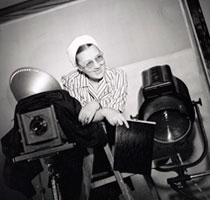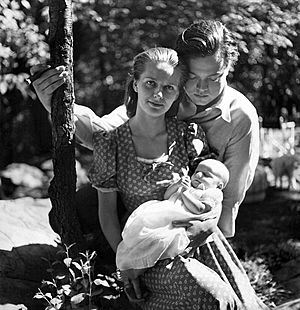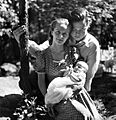Louise Dahl-Wolfe facts for kids
Quick facts for kids
Louise Dahl-Wolfe
|
|
|---|---|

Louise Dahl-Wolfe
|
|
| Born |
Louise Emma Augusta Dahl
November 19, 1895 San Francisco, California, U.S.
|
| Died | December 11, 1989 (aged 94) Allendale, New Jersey, U.S.
|
| Nationality | American |
| Alma mater | California School of Fine Arts |
| Known for | Photography |
| Spouse(s) |
Meyer Wolfe
(m. 1928; died 1985) |
Louise Dahl-Wolfe (born November 19, 1895 – died December 11, 1989) was a famous American photographer. She is best known for her amazing fashion photos. Many of her pictures appeared in the magazine Harper's Bazaar. She worked closely with the fashion editor Diana Vreeland.
Contents
Early Life and Photography Start
Louise Emma Augusta Dahl was born on November 19, 1895. She grew up in San Francisco, California. Her parents were immigrants from Norway. Louise was the youngest of three daughters.
In 1914, she started studying at the California School of Fine Arts. This school is now called the San Francisco Institute of Art. She learned about design and color there. She also studied painting, drawing, and anatomy for six years. After finishing school, Louise designed electric signs and interiors.
In 1921, Louise Dahl-Wolfe met photographer Anne Brigman. Anne inspired her to try photography. Louise even built her first darkroom enlarger herself! She used a tin can, an apple crate, and a chocolate box part. In 1923, she studied design and architecture in New York. From 1927 to 1928, she traveled with photographer Consuelo Kanaga. This trip made her even more interested in photography. Her first published photo was called Tennessee Mountain Woman. It appeared in Vanity Fair. In 1928, she married the American sculptor Meyer Wolfe. He often helped her by building backgrounds for her photos.
Photography Career Highlights
Louise Dahl-Wolfe was famous for taking pictures outdoors. She loved using natural light in faraway places. She traveled from South America to Africa for her photos. This style became known as "environmental" fashion photography. Other photographers at the time used warm, reddish colors. But Dahl-Wolfe preferred cooler colors. She even fixed her own photo proofs. Once, she changed a sofa's color from green to dark magenta.
She liked taking portraits more than fashion photos. Some famous people she photographed include Mae West, Vivien Leigh, and Orson Welles. She also helped discover a young Lauren Bacall. Lauren Bacall was a teenager when Dahl-Wolfe photographed her. This photo appeared on the March 1943 cover of Harper's Bazaar. One of her favorite models was Mary Jane Russell. Mary Jane appeared in about 30% of Dahl-Wolfe's pictures. Louise Dahl-Wolfe greatly influenced other photographers. These included Irving Penn and Richard Avedon. Milton H. Greene, a famous fashion photographer, was one of her assistants.
From 1933 to 1960, Dahl-Wolfe had a photo studio in New York City. She took pictures for ads and fashion brands. These included stores like Bonwit Teller and Saks Fifth Avenue. From 1936 to 1958, Dahl-Wolfe worked as a fashion photographer for Harper’s Bazaar. She created 86 magazine covers and 600 color pages. She also took countless black-and-white photos. She worked with editor Carmel Snow and art director Alexey Brodovitch. She also collaborated with fashion editor Diana Vreeland. In 1950, she was named one of "America's Outstanding Woman Photographers." This was in the September issue of Foto magazine. After 1958, she worked as a freelance photographer. She took photos for Vogue and Sports Illustrated. She retired in 1960.
Louise Dahl-Wolfe spent many of her later years in Nashville, Tennessee. She passed away in New Jersey in 1989 from pneumonia. Her complete collection of work is kept at the Center for Creative Photography. This center is at the University of Arizona in Tucson. They also manage the copyright for her work.
In 1999, a documentary film was made about her. It was called Louise Dahl-Wolfe: Painting with Light. The film showed rare footage of Dahl-Wolfe. It also included many interviews with her.
Photography Style and Impact
Louise Dahl-Wolfe was a very important fashion photographer of the 20th century. She was a true innovator and influenced the fashion world a lot. She was most famous for her work with Harper's Bazaar. Dahl-Wolfe was seen as a pioneer of the 'female gaze' in fashion. This means she showed women in a new way.
During World War II, Dahl-Wolfe helped create a new image for American women. Her photos showed them as strong and independent. She often took pictures outside the studio. She traveled to exciting places like Tunisia, Cuba, and South America. Her models looked natural, almost as if she just happened to capture them. Dahl-Wolfe was also great at using color in her photos. She focused on natural light, good composition, and balance. Her way of using sunlight and shooting outdoors became a standard for photographers even today.
The "American Look" During World War II
When the Nazis took over Paris in 1940, it affected fashion in America. The Fashion Group in New York City held a meeting. They discussed how this would impact American businesses. America was just recovering from the Great Depression. Now, French designs were cut off. Some people were unsure how to continue without European styles. But many decided to create a unique "American Look" to survive the war. Louise Dahl-Wolfe's work helped define this "American Look." It set new beauty standards and fashion trends.
Experts say she was the most important woman fashion photographer of her time. Valerie Steele noted that the energy in Dahl-Wolfe's work was a big part of the "American Look" rising.
In 1943, President Franklin Roosevelt declared March "Red Cross Month." This campaign raised $125 million for the war effort. This was a huge amount of money for America at the time. American women and fashion professionals worked together. They created a new style to fit these tough times.
Selected Works
Harper’s Bazaar Cover, March 1943
Dahl-Wolfe wanted to show patriotism in fashion during World War II. Her photos showed how the war affected the American fashion industry. The Harper’s Bazaar cover from March 1943 is one of her most famous photos.
The cover shows a young lady in front of an American Red Cross Blood Donation clinic. She looks very stylish in a navy suit, white blouse, and black gloves. She wears a cloche hat and holds a red bag. Her lipstick matches the bag. The young woman looks like she is waiting to donate blood or leaving the clinic. Her face looks calm, but also a bit empty. She might be disappointed, sad, or helpless. This reflects how many Americans felt during the war.
During World War II, many men went to fight abroad. Women were left at home. The woman on the cover represented all American women. They were determined to help with the war effort. Before, magazine covers often showed women as delicate. But this cover showed them as responsible individuals. They were ready to do their part. The March 1943 Harper’s Bazaar cover showed the new power women had in society. It reflected women who had started working for the first time. It also showed women who married soldiers and took care of their families. The model on the cover was 18-year-old Lauren Bacall. She later became a successful Hollywood actress. Diana Vreeland, who worked for Harper’s Bazaar and Vogue, discovered Lauren Bacall. She then put her on the cover of Harper's Bazaar.
Images for kids
See also
 In Spanish: Louise Dahl-Wolfe para niños
In Spanish: Louise Dahl-Wolfe para niños



